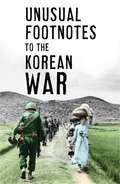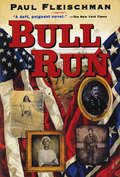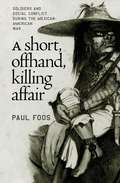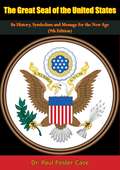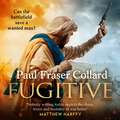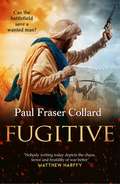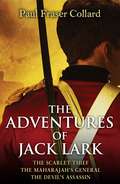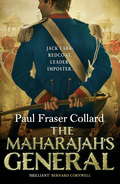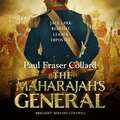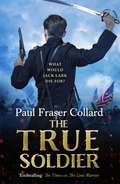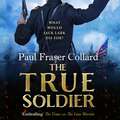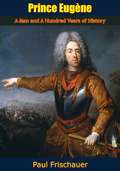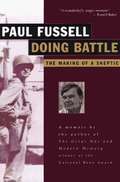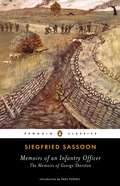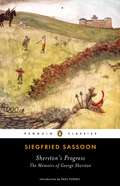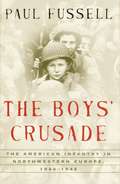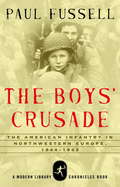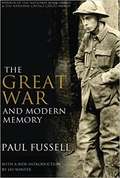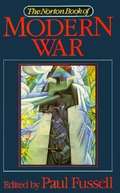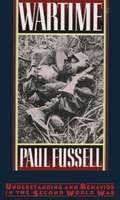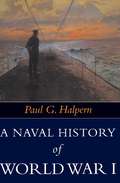- Table View
- List View
Unusual Footnotes to the Korean War
by Paul EdwardsThe Korean War is often a footnote in modern history, not given much recognition or studied in detailed. Osprey Digital presents this new look at a number of unusual events that happened during the conflict. Beginning with a look at the war itself and the history of US and Korean conflict, Paul Edwards goes onto tell the stories of the Salvation Army band that disappeared, Pulitzer Prize winning journalist, Maggie Higgins, Navy aid, including submarines and a mimic of the Dam Busters raid, and a look at the propaganda dropped over Korea by both sides. This miscellany of the war allows readers to dip in and out of this e-book only title, a perfect e-book for the daily commute.
The Scourge of War
by Paul F. DiehlJ. David Singer's legendary Correlates of War project represented the first comprehensive effort by political scientists to gather and analyze empirical data about the causes of war. In doing so, Singer and his colleagues transformed the face of twentieth-century political science. Their work provoked some of the most important debates in modern international relations -- about the rules governing territory, international intervention, and the so-called "democratic peace." Editor Paul F. Diehl has now convened some of the world's foremost international conflict analysis specialists to reassess COW's contribution to our understanding of global conflict. Each chapter takes one of COW's pathbreaking ideas and reevaluates it in light of subsequent world events and developments in the field. The result is a critical retrospective that will reintroduce Singer's important and still-provocative findings to a new generation of students and specialists.
Bull Run
by Paul FleischmanWinner of the Scott O'Dell Award for Historical Fiction * ALA Best Book for Young Adults * ALA Notable Children's BookIn this brilliant fictional tour de force, which the New York Times called "a deft, poignant novel," Newbery Medal-winning author Paul Fleischman re-creates the first great battle of the Civil War from the points of view of sixteen participants. Northern and Southern, male and female, white and black. Here are voices that tell of the dreams of glory, the grim reality, the hopes, horror, and folly of a nation discovering the true nature of war.
A Short, Offhand, Killing Affair
by Paul FoosThe Mexican-American War (1846-48) found Americans on new terrain. A republic founded on the principle of armed defense of freedom was now going to war on behalf of Manifest Destiny, seeking to conquer an unfamiliar nation and people. Through an examination of rank-and-file soldiers, Paul Foos sheds new light on the war and its effect on attitudes toward other races and nationalities that stood in the way of American expansionism.Drawing on wartime diaries and letters not previously examined by scholars, Foos shows that the experience of soldiers in the war differed radically from the positive, patriotic image trumpeted by political and military leaders seeking recruits for a volunteer army. Promised access to land, economic opportunity, and political equality, the enlistees instead found themselves subjected to unusually harsh discipline and harrowing battle conditions. As a result, some soldiers adapted the rhetoric of Manifest Destiny to their own purposes, taking for themselves what had been promised, often by looting the Mexican countryside or committing racial and sexual atrocities. Others deserted the army to fight for the enemy or seek employment in the West. These acts, Foos argues, along with the government's tacit acceptance of them, translated into a more violent, damaging variety of Manifest Destiny.
The Great Seal of the United States: Its History, Symbolism and Message for the New Age (9th Edition)
by Paul Foster CaseThe Great Seal of the United States, which was first published in 1935, is a fascinating exposition of the history and spiritual symbolism of an important American emblem that embodies the principles and ideals of the founders of this country.In this book, American occultist, B.O.T.A. founder, teacher and author Dr. Paul Foster Case reveals the Great Seal to be a profound spiritual glyph created by the Founding Fathers as a representation of the ideals of the Novo Ordo Seclorum, the New World Order.A fascinating, thought-provoking read.
Fugitive (Jack Lark)
by Paul Fraser CollardIn this ninth action-packed Victorian military adventure, Paul Fraser Collard's roguish hero Jack Lark - soldier, leader, imposter - crosses borders once more as he pursues a brand-new adventure in Africa. After five years away, Jack Lark - soldier, leader, imposter - is once more called to fight . . .London, 1868. Jack has traded the battlefield for business, running a thriving club in the backstreets of Whitechapel. But this underworld has rules and when Jack refuses to comply, he finds himself up against the East End's most formidable criminal - with devastating consequences.A wanted man, Jack turns to his friend Macgregor, an ex-officer, treasure hunter and his ticket out of England. Together they join the British army on campaign across the tablelands of Abyssinia to the fortress of Magdala, a high-stakes mission to free British prisoners captured by the notorious Emperor Tewodros.But life on the run can turn dangerous, especially in a land ravaged by war . . . Praise for the Jack Lark series:'Brilliant' Bernard Cornwell'Enthralling' The Times 'Dusty deserts, showdowns under the blistering sun, bloodthirsty bandoleros, rough whisky and rougher men. Bullets fly, emotions run high and treachery abounds in The Lost Outlaw... an exceptionally entertaining historical action adventure' Matthew Harffy'I love a writer who wears his history lightly enough for the story he's telling to blaze across the pages like this. Jack Lark is an unforgettable new hero' Anthony Riches'You feel and experience all the emotions and the blood, sweat and tears that Jack does... I devoured it in one sitting' Parmenion Books'Expect ferocious, bloody action from the first page. Fast-paced, compelling, and with more villains than a Clint Eastwood classic, this unputdownable novel strongly reminded me of that legend of western writers, Louis L'Amour. A cracking read!' Ben Kane(P)2020 Headline Publishing Group Ltd
Fugitive (Jack Lark, Book 9)
by Paul Fraser Collard'Once again, Paul Fraser Collard proves he is a true master of action adventure' MATTHEW HARFFY'Like all the best vintages Jack Lark has aged to perfection. Scarred, battered and bloody, his story continues to enthral' ANTHONY RICHESRoguish hero Jack Lark - soldier, leader, imposter - crosses borders once more as he pursues a brand-new adventure in Africa. For fans of Bernard Cornwell's Sharpe series, Matthew Harffy and Patrick O'Brian.CAN THE BATTLEFIELD SAVE A WANTED MAN?London, 1868. Jack Lark is now a businessman, running a thriving club in the Whitechapel backstreets. But when he goes up against the East End's most notorious criminal, the consequences are devastating.A wanted man, Jack joins the British army on campaign across Abyssinia, a high-stakes mission that returns him to the battlefield and on to the fortress of Magdala where the formidable Emperor Tewodros has taken British subjects prisoner.But life on the run can turn dangerous, especially in a land ravaged by war . . .Praise for the Jack Lark series:'Brilliant' Bernard Cornwell'Enthralling' The Times'Bullets fly, emotions run high and treachery abounds' Matthew Harffy'Expect ferocious, bloody action from the first page' Ben Kane'You feel and experience all the emotions and the blood, sweat and tears that Jack does... I devoured it in one sitting' Parmenion Books
Fugitive (Jack Lark, Book 9)
by Paul Fraser Collard'Once again, Paul Fraser Collard proves he is a true master of action adventure' MATTHEW HARFFY'Like all the best vintages Jack Lark has aged to perfection. Scarred, battered and bloody, his story continues to enthral' ANTHONY RICHESRoguish hero Jack Lark - soldier, leader, imposter - crosses borders once more as he pursues a brand-new adventure in Africa. For fans of Bernard Cornwell's Sharpe series, Matthew Harffy and Patrick O'Brian.CAN THE BATTLEFIELD SAVE A WANTED MAN?London, 1868. Jack Lark is now a businessman, running a thriving club in the Whitechapel backstreets. But when he goes up against the East End's most notorious criminal, the consequences are devastating.A wanted man, Jack joins the British army on campaign across Abyssinia, a high-stakes mission that returns him to the battlefield and on to the fortress of Magdala where the formidable Emperor Tewodros has taken British subjects prisoner.But life on the run can turn dangerous, especially in a land ravaged by war . . .Praise for the Jack Lark series:'Brilliant' Bernard Cornwell'Enthralling'The Times'Bullets fly, emotions run high and treachery abounds' Matthew Harffy'Expect ferocious, bloody action from the first page' Ben Kane'You feel and experience all the emotions and the blood, sweat and tears that Jack does... I devoured it in one sitting'Parmenion Books
The Adventures of Jack Lark: the Jack Lark omnibus
by Paul Fraser CollardThe first three Victorian military adventures featuring hero Jack Lark, now available together in ebook. If you love Bernard Cornwell's Sharpe series, Matthew Harffy and Patrick O'Brian, you won't want to miss Paul Fraser Collard's action-packed series.INTRODUCING ROGUISH HERO JACK LARK: SOLDIER, LEADER, IMPOSTER.'Brilliant' BERNARD CORNWELL'Once again, Paul Fraser Collard proves he is a true master of action adventure' MATTHEW HARFFY'Like all the best vintages Jack Lark has aged to perfection. Scarred, battered and bloody, his story continues to enthral' ANTHONY RICHES_________THE SCARLET THIEFCrimean Peninsula, 1854. The men of the King's Royal Fusiliers are in terrible trouble. Young officer Jack Lark has to act immediately and decisively. His life and the success of the campaign depend on it. But does he have the mettle, the officer qualities that are the life blood of the British Army?From a poor background in London's East End, Lark has risen through the ranks by stealth and guile and now he faces the ultimate test...THE MAHARAJAH'S GENERALBombay, 1856. Jack Lark barely survived the Battle of the Alma. In hospital, wounded, and with his stolen life left lying on the battlefield, he grasps a chance to prove himself a leader once more. Poor Captain Danbury is dead, but Jack will travel to his new regiment in India, under his name.Exposed as a fraud, he's rescued by the chaplain's beautiful daughter, who has her own reasons to escape. They seek desperate refuge with the Maharajah of Sawadh, the charismatic leader whom the British Army must subdue. And, in return for his safety, Jack finds he must train the very army the British may soon have to fight...THE DEVIL'S ASSASSINBombay, 1857. Jack Lark is living precariously as an officer when his heroic but fraudulent past is discovered by the Devil - Major Ballard, the army's intelligence officer. Ballard is gathering a web of information to defend the British Empire, and he needs a man like Jack on his side. Not far away, in Persia, the Shah is moving against British territory and, with the Russians whispering in his ear, seeks to conquer the crucial city of Herat. As the British march to war, Jack learns that secrets crucial to the campaign's success are leaking into their enemies' hands. Ballard has brought him to the battlefield to end a spy's deceit. But who is the traitor?_________READERS LOVE THE JACK LARK SERIES:'Jack Lark is one of my favourite literary creations' 5* Reader Review'Up there with the best of the genre' 5* Reader Review'Collard's development of Lark is brilliant' 5* Reader Review'This truly is edge of the seat writing' 5* Reader Review'A breathless, memorable read and I recommend it completely' 5* Reader Review'SO good. Redcoats, gunpowder, and the horror of battle. Anyone who read Sharpe should devour this . . . A masterclass of grit and determination' 5* Reader Review'WOW. This is a very fast paced story that I found incredibly difficult to put down . . . If you like Victorian novels especially military ones, this series is definitely for you' 5* Reader Review
The Maharajah's General (Jack Lark, Book 2): A fast-paced British Army adventure in India
by Paul Fraser CollardIn The Maharajah's General by Paul Fraser Collard Jack Lark returns to the battlefield under a new name to face greater adventures in a brutal land. A must-read for fans of Bernard Cornwell and Simon Scarrow. 'Collard ... evokes the horror of that era with great brio. Enthralling' The TimesJack Lark barely survived the Battle of the Alma. As the brutal fight raged, he discovered the true duty that came with the officer's commission he'd taken. In hospital, wounded, and with his stolen life left lying on the battlefield, he grasps a chance to prove himself a leader once more. Poor Captain Danbury is dead, but Jack will travel to his new regiment in India, under his name.Jack soon finds more enemies, but this time they're on his own side. Exposed as a fraud, he's rescued by the chaplain's beautiful daughter, who has her own reasons to escape. They seek desperate refuge with the Maharajah of Sawadh, the charismatic leader whom the British Army must subdue. He sees Jack as a curiosity, but recognises a fellow military mind. In return for his safety, Jack must train the very army the British may soon have to fight...
The Maharajah's General (Jack Lark, Book 2): A fast-paced British Army adventure in India
by Paul Fraser CollardIn The Maharajah's General by Paul Fraser Collard Jack Lark returns to the battlefield under a new name to face greater adventures in a brutal land. A must-read for fans of Bernard Cornwell and Simon Scarrow. 'Collard ... evokes the horror of that era with great brio. Enthralling' The TimesJack Lark barely survived the Battle of the Alma. As the brutal fight raged, he discovered the true duty that came with the officer's commission he'd taken. In hospital, wounded, and with his stolen life left lying on the battlefield, he grasps a chance to prove himself a leader once more. Poor Captain Danbury is dead, but Jack will travel to his new regiment in India, under his name.Jack soon finds more enemies, but this time they're on his own side. Exposed as a fraud, he's rescued by the chaplain's beautiful daughter, who has her own reasons to escape. They seek desperate refuge with the Maharajah of Sawadh, the charismatic leader whom the British Army must subdue. He sees Jack as a curiosity, but recognises a fellow military mind. In return for his safety, Jack must train the very army the British may soon have to fight...(P)2013 Headline Digital
The Maharajah's General: A fast-paced British Army adventure in India (Jack Lark, Book #2)
by Paul Fraser CollardIn The Maharajah's General by Paul Fraser Collard Jack Lark returns to the battlefield under a new name to face greater adventures in a brutal land. A must-read for fans of Bernard Cornwell and Simon Scarrow. 'Collard ... evokes the horror of that era with great brio. Enthralling' The TimesJack Lark barely survived the Battle of the Alma. As the brutal fight raged, he discovered the true duty that came with the officer's commission he'd taken. In hospital, wounded, and with his stolen life left lying on the battlefield, he grasps a chance to prove himself a leader once more. Poor Captain Danbury is dead, but Jack will travel to his new regiment in India, under his name.Jack soon finds more enemies, but this time they're on his own side. Exposed as a fraud, he's rescued by the chaplain's beautiful daughter, who has her own reasons to escape. They seek desperate refuge with the Maharajah of Sawadh, the charismatic leader whom the British Army must subdue. He sees Jack as a curiosity, but recognises a fellow military mind. In return for his safety, Jack must train the very army the British may soon have to fight...
The True Soldier (Jack Lark, Book 6): A gripping military adventure of a roguish British soldier and the American Civil War
by Paul Fraser CollardRoguish hero Jack Lark - dubbed 'Sharpe meets the Talented Mr Ripley' - travels to America to reinvent himself as the American Civil War looms... A must-read for fans of Bernard Cornwell and Simon Scarrow. 'Nobody writing today depicts the chaos, terror and brutality of war better than Paul Fraser Collard' Matthew Harffy 'This ain't the kind of war you are used to. It's brother against brother, countryman against countryman'April, 1861. Jack Lark arrives in Boston as civil war storms across America. A hardened soldier, Jack has always gone where he was ordered to go - and killed the enemy he was ordered to kill. But when he becomes a sergeant for the Union army, he realises that this conflict between North and South is different. Men are choosing to fight - and die - for a cause they believe in. The people of Boston think it will take just one, great battle. But, with years of experience, Jack knows better. This is the beginning of something that will tear a country apart - and force Jack to see what he is truly fighting for.
The True Soldier (Jack Lark, Book 6): A gripping military adventure of a roguish British soldier and the American Civil War
by Paul Fraser CollardRoguish hero Jack Lark - dubbed 'Sharpe meets the Talented Mr Ripley' - travels to America to reinvent himself as the American Civil War looms... A must-read for fans of Bernard Cornwell and Simon Scarrow. 'Nobody writing today depicts the chaos, terror and brutality of war better than Paul Fraser Collard' Matthew Harffy 'This ain't the kind of war you are used to. It's brother against brother, countryman against countryman'April, 1861. Jack Lark arrives in Boston as civil war storms across America. A hardened soldier, Jack has always gone where he was ordered to go - and killed the enemy he was ordered to kill. But when he becomes a sergeant for the Union army, he realises that this conflict between North and South is different. Men are choosing to fight - and die - for a cause they believe in. The people of Boston think it will take just one, great battle. But, with years of experience, Jack knows better. This is the beginning of something that will tear a country apart - and force Jack to see what he is truly fighting for. (P)2017 Headline Publishing Group Ltd
The True Soldier: Jack Lark 6
by Paul Fraser CollardIn The True Soldier by Paul Fraser Collard, roguish hero Jack Lark - dubbed 'Sharpe meets the Talented Mr Ripley' - travels to America to reinvent himself as the American Civil War looms... A must-read for fans of Bernard Cornwell and Simon Scarrow. 'Enthralling' - The Times'This ain't the kind of war you are used to. It's brother against brother, countryman against countryman'April, 1861. Jack Lark arrives in Boston as civil war storms across America. A hardened soldier, Jack has always gone where he was ordered to go - and killed the enemy he was ordered to kill. But when he becomes a sergeant for the Union army, he realises that this conflict between North and South is different. Men are choosing to fight - and die - for a cause they believe in. The people of Boston think it will take just one, great battle. But, with years of experience, Jack knows better. This is the beginning of something that will tear a country apart - and force Jack to see what he is truly fighting for.
Prince Eugène: A Man and A Hundred Years of History
by Paul FrischauerFirst published in 1934, this is a biography of Prince Eugene of Savoy (18 October 1663 - 21 April 1736), one of the most successful military commanders in modern European history.Born in Paris, he grew up around the French court of King Louis XIV. Initially prepared for a career in the church, by the age of 19 Eugene had determined on a military career; however, rejected by Louis XIV for service in the French army, he moved to Austria and transferred his loyalty to the Habsburg Monarchy.Spanning six decades, he served three Holy Roman Emperors: Leopold I, Joseph I, and Charles VI. He first saw action against the Ottoman Turks at the Siege of Vienna in 1683 and the subsequent War of the Holy League, before serving in the Nine Years’ War, fighting alongside his cousin, the Duke of Savoy. The Prince’s fame was secured with his decisive victory against the Ottomans at the Battle of Zenta in 1697, earning him Europe-wide fame.The Prince enhanced his standing during the War of the Spanish Succession, where his partnership with the Duke of Marlborough secured victories against the French on the fields of Blenheim (1704), Oudenarde (1708), and Malplaquet (1709). He gained further success in the war as Imperial commander in northern Italy, most notably at the Battle of Turin (1706). Renewed hostilities against the Ottomans in the Austro-Turkish War consolidated his reputation, with victories at the battles of Petrovaradin (1716), and the decisive encounter at Belgrade (1717).Throughout the late 1720s, Eugene’s influence and skilful diplomacy managed to secure the Emperor powerful allies in his dynastic struggles with the Bourbon powers: he helped to save the Habsburg Empire from French conquest; he broke the westward thrust of the Ottomans, liberating central Europe after a century and a half of Turkish occupation; and he was one of the great patrons of the arts whose building legacy can still be seen in Vienna today.
Doing Battle: The Making of a Skeptic
by Paul FussellFussell's life began in Pasadena, California, a pastoral middle-class sanctuary almost untouched by the Great Depression. He went as an innocent to nearby Pomona College, where he learned about drink and women, and spent afternoons marching on the football field with the ROTC. And then, when the United States entered World War II, the spell was broken. At nineteen he joined the army and began the central event of his life. He endured basic training, became a second lieutenant in the infantry, and, leading his platoon into battle, was seriously wounded. When he recovered, he vowed never to take orders again. His newly subversive sensibility would color all his later years, as a Harvard Ph.D. student, as a professor of literature, and as one of America's most distinguished commentators on twentieth-century life.
Memoirs of an Infantry Officer
by Paul Fussell Siegfried SassoonPersonal narratives of a British officer on the Western front during World War I. Copyright © Libri GmbH. All rights reserved.
Sherston's Progress
by Paul Fussell Siegfried SassoonThe third volume in Siegfried Sassoon’s beloved trilogy, The Complete Memoirs of George Sherston, with a new introduction by celebrated historian Paul Fussell A highly decorated English soldier and an acclaimed poet and novelist, Siegfried Sassoon won fame for his trilogy of fictionalized autobiographies that wonderfully capture the vanishing idylls of Edwardian England and the brutal realities of war. Having been deemed mentally ill for his anti-war sentiments and sent for treatment, George Sherston comes under the care of neurologist Dr. W. H. R. Rivers, who allows Sherston to sort through his attitudes toward the fighting (events that have also been semi-fictionalized by Pat Barker for her bestselling and critically acclaimed Regeneration Trilogy). After six months in the hospital, Sherston leaves to rejoin his regiment. He is soon dispatched to Ireland, where he attempts to reclaim some of the idyllic fox-hunting days of his youth, then to Palestine. He finally ends up at the Western Front in France, where he is shot in the head while on a reconnaissance mission and invalided back home. As the capstone of Sassoon's masterful Sherston trilogy, Sherston's Progress—whose evocation of Bunyan's Pilgrim's Progress is not at all accidental—literally brings home the unforgettable journey of George Sherston from aristocratic childhood through war hero and anti-war martyr, all the way to wounded veteran trying to move on from the Great War. .
The Boys' Crusade: The American Infantry in Northwestern Europe, 1944--1945
by Paul FussellBased in part on the author's own experiences, "The Boys' Crusade" provides a stirring narrative of what the war was actually like, from the point of view of the children --- for children they were --- who fought it. While dealing definitively with issues of strategy, leadership, context, and tactics, Fussell has an additional purpose: to tear away the veil of feel-good mythology that so often obscures and sanitizes war's brutal essence. Accordingly, he eschews every kind of sentimentalism, focusing instead on the raw action and human emotion triggered by the intimacy, horror, and intense sorrows of war, and honestly addressing the errors, waste, fear, misery, and resentments that plagued both sides. In the vast literature on World War II, The Boys' Crusade stands wholly apart. Fussell's profoundly honest portrayal of these boy soldiers underscores their bravery even as it deepens our awareness of their experiences. This book is both a tribute to their noble service and a valuable lesson for future generations.
The Boys' Crusade: The American Infantry in Northwestern Europe, 1944-1945
by Paul FussellThe Boys’ Crusade is the great historian Paul Fussell’s unflinching and unforgettable account of the American infantryman’s experiences in Europe during World War II. Based in part on the author’s own experiences, it provides a stirring narrative of what the war was actually like, from the point of view of the children—for children they were—who fought it. While dealing definitively with issues of strategy, leadership, context, and tactics, Fussell has an additional purpose: to tear away the veil of feel-good mythology that so often obscures and sanitizes war’s brutal essence. “A chronicle should deal with nothing but the truth,” Fussell writes in his Preface. Accord-ingly, he eschews every kind of sentimentalism, focusing instead on the raw action and human emotion triggered by the intimacy, horror, and intense sorrows of war, and honestly addressing the errors, waste, fear, misery, and resentments that plagued both sides. In the vast literature on World War II, The Boys’ Crusade stands wholly apart. Fussell’s profoundly honest portrayal of these boy soldiers underscores their bravery even as it deepens our awareness of their experiences. This book is both a tribute to their noble service and a valuable lesson for future generations.
The Great War and Modern Memory
by Paul FussellFussell writes: This book is about the British experience on the Western Front from 1914 to 1918 and some of the literary means by which it has been remembered, conventionalized, and mythologized. It is also about the literary dimensions of the trench experience itself. Indeed, if the book had a subtitle, it would be something like "An Inquiry into the Curious Literariness of Real Life." <P><P> Winner of the National Book Award
The Norton Book of Modern War
by Paul FussellIn dozens of selections that range from classic fiction and poetry to journalistic dispatches, this anthology presents the voices of this century's major conflicts: the First World War, the Spanish Civil War, the Second World War and the wars in Asia.
Wartime: Understanding and Behavior in the Second World War
by Paul FussellIn Wartime, Paul Fussell turns to the Second World War, the conflict in which he himself fought, to weave an intensely personal and wide-ranging narrative.
A Naval History of World War I
by Paul G. HalpernThere have been a number of studies published on the activities of British and German navies during World War I, but little on naval action in other arenas. This book offers for the first time a balanced history of the naval war as a whole, viewed from the perspective of all participants in all major theaters. The author's earlier examination The Naval War in the Mediterranean, 1914-1918, centered on submarine activities and allied efforts to counteract this new menace. With this welcome sequel he again takes the reader beyond those World War I operations staged on the North Sea. Halpern's clear and authoritative voice lends a cohesiveness to this encompassing view of the Italians and Austrians in the Adriatic; the Russians, Germans, and Turks in the Baltic and Black Seas; and French and British in the Mediterranean.Important riverine engagements--notably on the Danube--also are included, along with major colonial campaigns such as Mesopotamia and the Dardanelles. The role of neutral sea powers, such as the Swedes in the Baltic and the Dutch in the East Indies, is examined from the perspective of how their neutrality affected naval activity. Also discussed is the part played by the U.S. Navy and the often overlooked, but far from negligible, role of the Japanese navy. The latter is viewed in the context of the opening months of the war and in the Mediterranean during the height of the submarine crisis of 1917
